Discover the Rich Heritage of the Qu Family Compound: A Journey Through Time
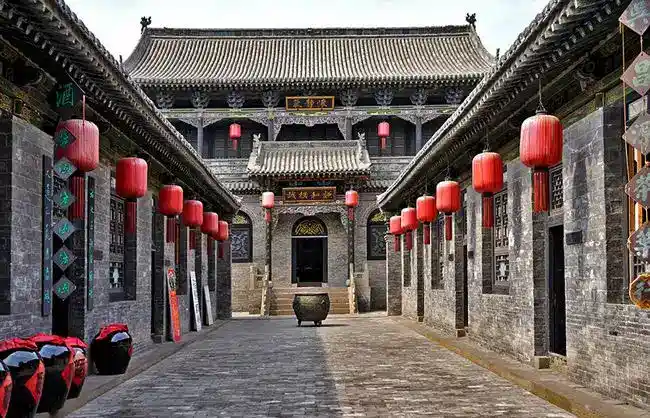
An Essential Guide to Visiting Qu Family Compound
In This Guide
- An Essential Guide to Visiting Qu Family Compound
- The Rich History and Legends of Qu Family Compound
- Main Highlights: What You Absolutely Can’t Miss
- Planning Your Visit: A Practical Guide
- Tickets: Prices, Booking, and Tips
- How to Get There: A Complete Transportation Guide
- Local Cuisine and Accommodation Nearby
- Frequently Asked Questions
- Final Thoughts on Your Trip
Nestled in the heart of Qi County, the Qu Family Compound (渠家大院) stands as a remarkable testament to the grandeur and complexity of Shanxi merchant culture during China’s Qing Dynasty. With over 300 years of history, this architectural marvel offers visitors not only a glimpse into the lives of one of China’s wealthiest families but also an opportunity to explore the intricate tapestry of traditional Chinese society.
As you approach the compound, its formidable walls rise like a fortress, hinting at the wealth and influence of the Qu family. Spanning an impressive 5,300 square meters, this estate features eight large courtyards, 19 smaller courtyards, and a staggering 240 rooms. Each space is meticulously designed, with a layout that guides visitors from lower, narrower passages into broader, higher areas—symbolizing the family’s hopes that future generations would achieve greater success and status.

Qu Family Compound.
What to Expect
Exploring the Qu Family Compound is akin to stepping back in time. Here’s what you can look forward to during your visit:
- Architectural Splendor: Marvel at the exquisite craftsmanship that characterizes the buildings, from intricately carved beasts atop the roofs—symbolizing the family’s dual roles as officials and merchants—to the thoughtful inscriptions that remind descendants to “Be Cautious of Your Tongue.”
- Rich History: Learn about the compound’s storied past, including its occupation during the Sino-Japanese War and the family’s temporary relocation to Chengdu. The remnants of a Japanese observation post, situated above one of the buildings, serve as a poignant reminder of this turbulent period.
- Cultural Insights: Engage with knowledgeable guides who will share fascinating anecdotes about the Qu family’s lifestyle, their business ventures, and their societal contributions, enriching your understanding of Shanxi’s merchant heritage.
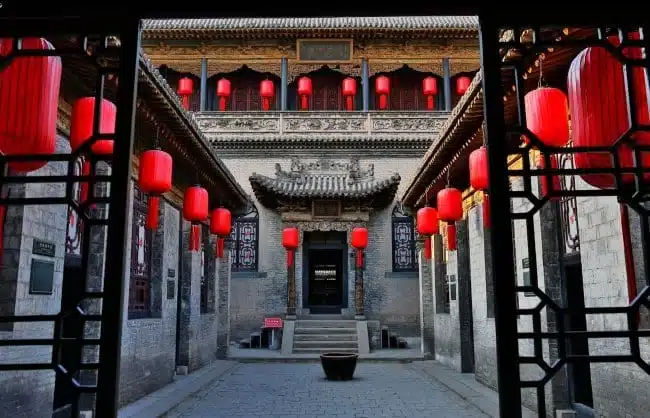
Qu Family Compound.
Practical Information
- Location: The compound is easily accessible, located at No. 33 East Main Street, Qi County.
- Best Time to Visit: To fully appreciate the tranquility and beauty of the compound, consider visiting during the early morning or late afternoon.
- Nearby Attractions: After your tour, take the opportunity to explore other historical sites in the vicinity, such as the Changyuchuan Teahouse and the Jinzhong Weights and Measures Museum.
Visiting the Qu Family Compound is more than just a cultural excursion; it’s an immersive experience that invites you to uncover the layers of history embedded in its walls. Prepare to be captivated by the stories of a family whose legacy continues to echo throughout time.
The Rich History and Legends of Qu Family Compound
The Qu Family Compound, a stunning testament to the wealth and influence of the Shanxi merchant class, is steeped in over 300 years of history. Constructed during the reign of the Qianlong Emperor in the Qing Dynasty, this architectural marvel spans an impressive 5,300 square meters and features five layers of courtyards, 240 rooms, and a fascinating array of legends and cultural significance.

Qu Family Compound.
A Legacy of Wealth and Power
The Qu family was among the most prominent merchants in Shanxi, dominating trade and commerce during their peak. The compound itself was part of a larger estate that encompassed ten such compounds across Qi County, showcasing the family’s vast wealth. With its high fortress-like walls and grand entrance, the compound resembles a small city, reflecting the family’s status and the importance of security in an era marked by conflict and upheaval.
Architectural Wonders
The architectural design of the compound is not merely for show; each element is imbued with meaning. Visitors will notice that as one moves through the complex, each courtyard becomes progressively larger and each doorway higher. This design symbolizes the aspiration for success and upward mobility, echoing a local saying that “exceptional people come forth by walking from the low to the high and from the narrow to the wide.” Such symbolism illustrates the Qu family’s hopes for their descendants to prosper and achieve higher positions in society.

Qu Family Compound.
Cultural Significance
The Qu Family Compound is a treasure trove of cultural artifacts and legends. Within its walls, intricate carvings and auspicious motifs abound, including mythical beasts and inscriptions that contain important life lessons. For instance, the phrase “Be Cautious of Your Tongue” is prominently displayed, serving as a reminder to future generations about the importance of discretion in both business and personal affairs. This reflects a deep-rooted belief among the Qu family that many troubles arise from careless speech.
Tales of Resilience
The compound also bears witness to historical events that shaped the region. During the Sino-Japanese War, the Qu family faced adversity as the Japanese occupied their estate, forcing them to relocate their operations to Chengdu. Despite such challenges, the family’s resilience is evident in the preservation of their legacy. Today, visitors can see remnants of the occupation, such as an observation post constructed by the Japanese on one of the compound’s roofs, providing a glimpse into the complex history of the site.
A Living Museum
As a UNESCO World Heritage Site, the Qu Family Compound not only offers insight into the lives of the wealthy merchant class but also serves as a living museum that continues to educate and inspire. The juxtaposition of architectural beauty and historical depth makes it a must-visit destination for those seeking to understand the intricacies of Chinese history and culture.
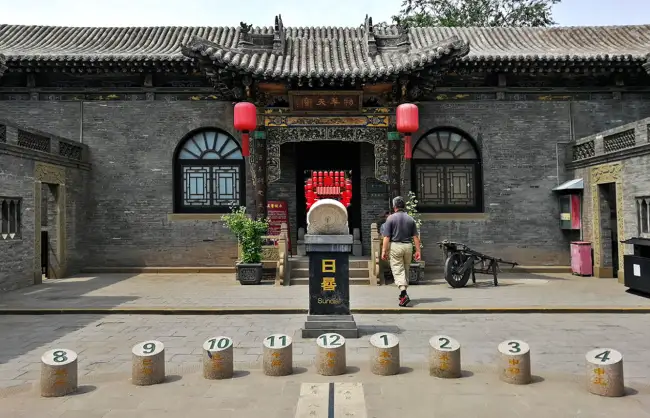
Qu Family Compound.
Conclusion
Exploring the Qu Family Compound is more than a mere stroll through an old estate; it is an immersive experience into the cultural heritage of Shanxi merchants. Each corner of this remarkable compound whispers stories of ambition, caution, and resilience, inviting visitors to reflect on the rich tapestry of Chinese history that continues to unfold. Whether you are an avid historian or a casual traveler, the Qu Family Compound promises a memorable journey into the past.
Main Highlights: What You Absolutely Can’t Miss
Discovering the Splendor of the Qu Family Compound
Delve into the rich tapestry of Chinese history at the Qu Family Compound, a magnificent estate that is a testament to the grandeur of the Shanxi merchant class during the Qing Dynasty. With over 300 years of history, this architectural marvel offers a glimpse into the lives of one of the most prominent families of the era. Here are the highlights you absolutely can’t miss during your visit:

Qu Family Compound.
A Fortress of Elegance
As you approach the compound, you’ll be struck by its imposing exterior. The compound is surrounded by 10-meter high walls and features a striking tall gate that gives it the appearance of a fortress. The observation pavilion offers a panoramic view of the front area, setting the stage for the journey into its inner sanctum.
The Unique Layout
One of the standout features of the Qu Family Compound is its remarkable five-layer courtyard design. The compound spans over 5,300 square meters and includes eight large courtyards, 19 smaller courtyards, and an impressive 240 rooms. This architectural complexity symbolizes the family’s aspirations, as each courtyard and door heightens with progression, reflecting the belief that success and stature are achieved through perseverance.

Qu Family Compound.
Intricate Carvings and Symbolism
As you wander through the compound, take note of the detailed carvings adorning the buildings. These intricate designs aren’t merely decorative; they convey significant meanings. For instance, the open-mouthed beasts on the roofs symbolize the family’s dual identity as both businessmen and officials, suggesting that they were “fed” by government salaries. Conversely, the phrase “Be Cautious of Your Tongue” inscribed on various structures serves as a reminder of the importance of discretion in both business and personal matters.
Historical Significance
The Qu Family was an influential part of the Shanxi merchant culture, with their estate once occupying much of Qi County. Their historical prowess is underscored by the fact that they owned over 10 compounds with more than 1,000 rooms. During the sino-Japanese War, the family temporarily relocated their headquarters to Chengdu, leaving behind a poignant reminder of their past—a Japanese observation post that still stands atop one of the buildings.
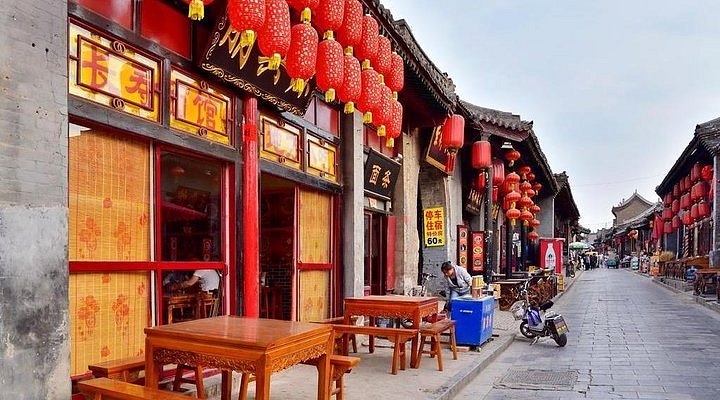
Qu Family Compound.
Nearby Attractions
Your visit to the Qu Family Compound can be complemented by exploring other historical sites in the area. Just a short walk away, you’ll find the Changyuchuan Teahouse, also part of the Qu family legacy, where you can enjoy traditional Chinese tea and reflect on the history surrounding you.
Practical Tips for Your Visit
- Guided Tours: To fully appreciate the richness of the compound’s history and symbolism, consider joining a guided tour. Knowledgeable guides can provide context and detail that will enhance your experience.
- Photography: The compound’s architecture and gardens are breathtaking, so bring your camera to capture the intricate details and grand vistas.
- Timing Your Visit: Early mornings or late afternoons are ideal for avoiding crowds and enjoying a more serene atmosphere.
The Qu Family Compound is not just a destination; it’s an immersive experience into the opulent past of China’s merchant elite. Make sure to include this historical gem in your travel itinerary and witness firsthand the enduring legacy of the Qu family.
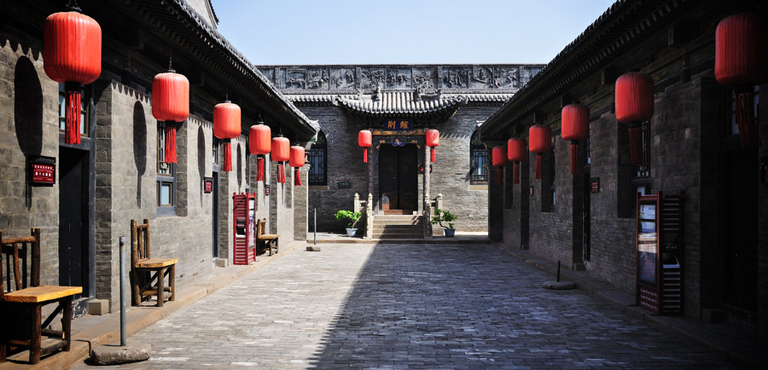
Qu Family Compound.
Planning Your Visit: A Practical Guide
Your Essential Guide to Visiting the Qu Family Compound
Nestled in the heart of Qi County, the Qu Family Compound is a remarkable testament to China’s rich merchant history. With its intricate architecture and storied past, this compound is a must-visit for those eager to delve into the cultural tapestry of Shanxi Province. Here’s everything you need to know to plan your visit.
Getting There
Address:
No.33 East Main Street, Qi County, Shanxi, China
Transport Options:
– By Plane: The nearest major airports are Taiyuan Airport (TYN) and Beijing Daxing International Airport (PKX). From either airport, you can take a taxi or book a private transfer to Qi County.
– By Train: High-speed trains run regularly to Pingyao Ancient Town from major cities like Beijing and Xi’an. Once in Pingyao, you can take a taxi or a local bus to reach the compound.
– By Bus: Local buses connect Qi County with surrounding towns and cities, making it accessible for budget travelers.

Qu Family Compound.
Opening Hours and Admission
- Hours: The compound is typically open from 8:00 AM to 6:00 PM, but it’s advisable to check for any seasonal changes or special closures before your visit.
- Admission Fee: As of now, the entrance fee is approximately 50 RMB, which grants you access to the main areas of the compound. Guided tours may be available for an additional fee.
What to Expect
The Qu Family Compound covers over 5,300 square meters and showcases a unique architectural style with five layers of courtyards. Here are some highlights:
- Architectural Features: Marvel at the intricate carvings and traditional design that reflect the wealth and status of the Qu family during the Qing Dynasty. The compound includes eight large courtyards and 19 smaller ones, all arranged to lead visitors from narrow, lower spaces to wider, more open areas—symbolizing prosperity and social advancement.
- Historical Significance: Learn about the Qu family’s prominence as merchants during the late imperial period and their role in the local economy. The compound has survived various historical upheavals, including occupation during the Sino-Japanese War.
- Cultural Insights: Take note of the carvings and inscriptions throughout the complex, such as “Be Cautious of Your Tongue,” reflecting the family’s values and beliefs about speech and conduct.

Qu Family Compound.
Nearby Attractions
After exploring the Qu Family Compound, don’t miss these nearby sites:
- Changyuchuan Teahouse: A charming spot to relax and enjoy traditional tea.
- Jinzhong Weights and Measures Museum: Dive deeper into the region’s history and commerce.
- Pingyao Ancient Town: A UNESCO World Heritage Site, just a short distance away, where you can stroll through ancient streets and immerse yourself in the local culture.
Tips for Your Visit
- Guided Tours: Consider joining a guided tour for richer insights into the history and architecture of the compound. Local guides often share fascinating stories that enhance your experience.
- Photography: The compound offers stunning photo opportunities, so bring your camera. However, be mindful of any restrictions on flash photography in certain areas.
- Cultural Respect: As a historical site, maintain a respectful demeanor, especially when interacting with artifacts and exhibits.
- Plan for Weather: Shanxi can experience a range of weather conditions, so check the forecast and dress accordingly.

Qu Family Compound.
Conclusion
Visiting the Qu Family Compound is more than just a sightseeing excursion; it’s an opportunity to step back in time and experience the grandeur of China’s merchant culture. With its rich history, stunning architecture, and cultural significance, this compound is a highlight of any journey through Shanxi. Plan your visit wisely, and prepare to be captivated by the stories that unfold within its walls.
Tickets: Prices, Booking, and Tips
Ticket Information for Qu Family Compound
Visiting the Qu Family Compound (渠家大院) in Qi County offers a fascinating glimpse into the rich history of Shanxi merchants and their architectural legacy. Here’s everything you need to know about tickets, pricing, and booking tips to enhance your visit.
Ticket Prices
- General Admission: Approximately ¥60 (around $9 USD)
- Discounted Tickets: Available for students and seniors, usually priced at ¥30 (around $4.50 USD). Valid identification is required.
- Children under 1.2 meters: Free entry.
Booking Information
- On-site Purchase: Tickets can be purchased directly at the entrance of the Qu Family Compound. It is advisable to arrive early, especially during peak tourist seasons, to avoid long queues.
- Online Booking: Some travel platforms and local tour agencies offer advance booking options. Booking online can save time and provide the convenience of securing your visit in advance.
Tips for Your Visit
- Visit During Off-Peak Hours: To fully enjoy the tranquility of the compound and capture stunning photographs without large crowds, consider visiting early in the morning or late in the afternoon.
- Guided Tours: While self-exploration is rewarding, joining a guided tour can enrich your experience. Knowledgeable guides offer insights into the architectural features and historical significance of the compound, including its unique five-layer courtyard design.
- Combine with Nearby Attractions: The Qu Family Compound is close to other notable sites like the Changyuchuan Teahouse and Jinzhong Weights and Measures Museum. Consider purchasing a combined ticket if available or planning a day to explore these nearby attractions.
- Cultural Etiquette: As you wander through the compound, remember to be respectful of the historical site. Avoid touching artifacts and maintain a low noise level to preserve the serene atmosphere.
Additional Information
- Location: No.33 East Main Street, Qi County, Shanxi Province, China.
- Opening Hours: Typically open from 8:30 AM to 5:30 PM, but it’s advisable to check for seasonal variations or special events.
By planning your visit to the Qu Family Compound with this information, you’ll ensure a smoother and more enriching experience as you delve into the fascinating world of Shanxi’s merchant culture.
How to Get There: A Complete Transportation Guide
Getting to the Qu Family Compound: Your Essential Transportation Guide
Visiting the Qu Family Compound, a remarkable testament to the architectural grandeur of Shanxi’s merchant culture, is an enriching experience for those interested in Chinese history and culture. Located in Qi County, the compound is easily accessible from several key transportation hubs. Here’s how to get there seamlessly.
By Air
If you’re traveling from international destinations, the nearest major airport is Taiyuan Airport (TYN), located approximately 90 kilometers (56 miles) from the Qu Family Compound. The airport serves both domestic and limited international flights. From the airport, you have several options:
- Taxi: The most convenient option, taxis from Taiyuan Airport to Qi County will take about 1.5 hours, costing around ¥200-¥300 (approx. $30-$45).
- Airport Shuttle: Look for shuttle buses that operate to major cities in Shanxi, though they may not directly reach Qi County; check the latest schedules.
By Train
Shanxi province has a well-connected train network, making travel quite easy.
- From Beijing:
- Take a high-speed train from Beijing West Railway Station to Pingyao Ancient City Station. The journey takes around 4-5 hours.
-
Once in Pingyao, you can take a taxi or a local bus to Qi County, which is about 20 kilometers (12 miles) away. Taxis typically cost around ¥60-¥100 (approx. $9-$15) and take about 30 minutes.
-
From Taiyuan:
- High-speed trains also run frequently from Taiyuan Railway Station to Pingyao, with a travel time of about 1.5 hours.
- Again, taxis or local buses will get you to Qi County from Pingyao.
By Bus
For budget-conscious travelers, buses are a great option:
- From Taiyuan: Long-distance buses depart from Taiyuan Bus Station to Qi County. The trip takes about 2-3 hours and costs approximately ¥50 (about $7.50).
- From Pingyao: Buses are available from the Pingyao bus station to Qi County, typically taking around 30 minutes and costing less than ¥20 (around $3).
Local Transportation in Qi County
Once you arrive in Qi County, getting to the Qu Family Compound is straightforward:
- Walking: The compound is centrally located; if you’re staying nearby, it’s a pleasant walk through the historic streets.
- Bicycles: Renting a bicycle is a charming way to explore the area. Several local shops offer rentals.
- Taxis: Local taxis are available and can be hailed easily for short rides if needed.
Recommended Tours
If you prefer a guided experience, consider booking a private tour that includes transportation. Many local tours from Pingyao cover the Qu Family Compound and other nearby attractions like the Qiao Family Compound and ancient city walls.
Conclusion
With its rich history and captivating architecture, the Qu Family Compound is a must-visit for anyone interested in Chinese culture. Whether you choose to fly, take a train, or hop on a bus, reaching this historical gem is uncomplicated. Prepare yourself for a journey back in time as you explore the significant heritage of the Shanxi merchants. Happy travels!
Local Cuisine and Accommodation Nearby
Visiting the Qu Family Compound in Qi County is not just an exploration of history; it’s also an opportunity to indulge in local cuisine and experience authentic accommodations that reflect the rich culture of Shanxi Province. Here’s a taste of what awaits you just a stone’s throw from this impressive architectural marvel.
Culinary Delights
LiMing XiaoChi Fang
Just a short walk from the Qu Family Compound, this charming eatery is a must-visit for fans of Szechuan cuisine. With a cozy atmosphere and friendly service, you can savor dishes that are both flavorful and unique. Be sure to try their spicy hot pot and hand-pulled noodles, which are local favorites. The casual setting makes it perfect for a relaxed meal after a day of sightseeing.
Changyuchuan Teahouse
Located near the Qu Family Compound, this traditional teahouse offers an authentic taste of Chinese tea culture. Enjoy a serene environment as you sample various brews, including local Shanxi tea. Pair your tea with some steamed dumplings or sweet pastries for a delightful afternoon snack. The teahouse itself is steeped in history, providing a picturesque backdrop to your culinary experience.
Where to Stay
Pingyao Yucheng Mansion
For those looking to immerse themselves in history, the Pingyao Yucheng Mansion offers an exceptional blend of comfort and tradition. This hotel, located within the ancient city of Pingyao, features beautifully restored rooms that echo the architectural style of the Qing Dynasty. With modern amenities and a warm ambiance, it’s an ideal base for exploring the Qu Family Compound and nearby attractions.
Qu Family Compound Guesthouse
For a truly unique experience, consider staying at a guesthouse that is part of the Qu Family Compound itself. This option allows you to enjoy the compound’s architectural beauty after the day-trippers have left. The guesthouse offers a variety of rooms that showcase traditional decor, and the hosts often provide insights into the history of the compound, enhancing your stay with personal anecdotes and stories.
Conclusion
As you plan your visit to the Qu Family Compound, make sure to set aside time to enjoy the local cuisine and accommodations that enrich your experience. Whether you’re indulging in spicy Szechuan dishes or resting in a historical mansion, the charm of Qi County and its surroundings will leave a lasting impression.
Frequently Asked Questions
Frequently Asked Questions
1. What is the history of the Qu Family Compound?
The Qu Family Compound, built during the reign of Emperor Qianlong in the Qing Dynasty, boasts a rich history of over 300 years. It was home to one of the prominent Shanxi merchant families, known for their substantial wealth and influence, covering an area of more than 5,300 square meters with multiple courtyards and rooms.
2. How large is the Qu Family Compound?
The compound is extensive, featuring eight large courtyards, 19 smaller courtyards, and a total of 240 rooms. Its unique design includes five layers of courtyards, symbolizing the aspiration for prosperity and higher status for future generations of the Qu family.
3. What architectural features should I look for?
Visitors will find that the compound resembles a fortress, complete with 10-meter high walls and a tall gate. Notable features include intricately carved beasts on the roofs, which symbolize the family’s ties to both business and government. The design of the compound encourages progression from lower to higher levels, reflecting the family’s hopes for their descendants.
4. Is there a significance to the compound’s design?
Yes, the layout of the compound is intentional. Each new door is taller than the last, and each courtyard is wider, embodying the saying that exceptional individuals emerge from humble beginnings. This design reflects the Qu family’s wishes for their descendants to achieve greater wealth and higher government positions.
5. Are there any nearby attractions?
Absolutely! Visitors to the Qu Family Compound can also explore nearby sites such as Changyuchuan Teahouse, Zhenhe Building, and other historic structures in Qi County. The area is rich in cultural heritage, making it ideal for a full day of exploration.
6. Can I visit the Qu Family Compound without a tour guide?
While it is possible to visit independently, it is highly recommended to hire a guide. A knowledgeable guide can provide valuable insights into the history, architecture, and cultural significance of the compound, enriching your experience.
7. What should I know about visiting the compound?
Visitors should be prepared for a walk, as the compound is large and includes multiple courtyards and rooms. Wear comfortable shoes and be ready to explore the intricate details of the architecture. Additionally, consider going in the morning or late afternoon to avoid crowds and enjoy a more tranquil experience.
8. How do I get to the Qu Family Compound?
The Qu Family Compound is located at No.33 East Main Street, Qi County, Shanxi Province. It is accessible by public transportation or taxi from major cities nearby, such as Pingyao. If you’re traveling from Pingyao, consider joining a guided tour that includes transportation for added convenience.
Final Thoughts on Your Trip
As your journey through the Qu Family Compound comes to an end, take a moment to reflect on the rich tapestry of history and culture you have experienced. This remarkable site, with its intricate architecture and deep-rooted stories, offers a unique glimpse into the life of one of Shanxi’s most influential merchant families during the Qing Dynasty.
A Journey Through Time
Exploring the compound’s expansive courtyards and intricately carved details allows you to step back in time. Imagine the prosperity that once filled these walls, the bustling life of merchants, and the whispers of family tales echoing through the corridors. The Qu Family Compound is not just a historical site; it is a testament to the enduring spirit of the Shanxi merchants, whose legacies continue to shape the region today.
Highlights to Remember
- Architectural Grandeur: Marvel at the compound’s fort-like structure, featuring high walls and multiple courtyards that symbolize the family’s aspirations for wealth and status.
- Cultural Significance: Discover the intricate symbolism behind the architectural details, such as the open-mouthed beasts and the cautionary phrases inscribed on the buildings.
- Historical Context: Learn about the impact of the Sino-Japanese War on the Qu family and their resilience during tumultuous times.
Final Reflections
As you leave the Qu Family Compound, carry with you the stories of the past and the lessons inscribed in its very fabric. This experience not only enriches your understanding of Chinese history but also deepens your appreciation for the cultural nuances that define this ancient civilization.
May your travels inspire further exploration and connection to the vibrant narratives that continue to flourish across China. Safe travels, and may your next adventure be as enlightening as this one!